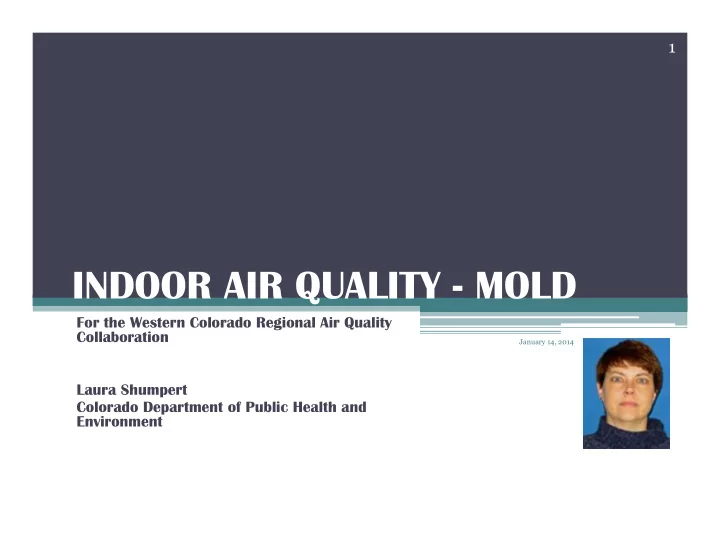

1 INDOOR AIR QUALITY - MOLD For the Western Colorado Regional Air Quality Collaboration January 14, 2014 Laura Shumpert Colorado Department of Public Health and Environment
2 January 14, 2014 What is “Indoor Air Quality” • “The air quality within and around buildings and structures, especially as it relates to the health and comfort of building occupants.” ▫ The building itself – construction and materials ▫ The area around buildings – nature and neighbors ▫ Building occupants – activities and product usage
3 January 14, 2014 “Health and Comfort” • These two words encompass a huge number of variables: ▫ Health Specific symptoms related to time spent in a building SBS ▫ Comfort Temperature, relative humidity, lighting, noise and so on
4 January 14, 2014 Diagnosing IAQ Issues • Often extremely difficult to pinpoint the problem ▫ May be more than one issue ▫ Resolution may be by trial and error • May be expensive to fix ▫ May not be economically feasible • Even more difficult to change people’s behavior
5 January 14, 2014 IAQ and “Mold” • The issue may or may not be mold
6 January 14, 2014 What are Fungi? • Molds, mushrooms, mildews, and yeasts are all classified as fungi. • They grow best in warm, damp, and humid conditions, and reproduce and spread by making spores. • There are thousands of species of fungi.
7 January 14, 2014 • Fewer than 500 fungal species have been described as human pathogens. • Exposure to fungi can cause symptoms such as nasal stuffiness, eye irritation, wheezing, or skin irritation.
8 January 14, 2014 Difficulties dealing with Fungi • Fungi are, at the same time, everywhere and nowhere. • Fungi secrete enzymes that digest the material in which they are imbedded and absorb the released nutrients .
9 January 14, 2014 Sampling • Air sampling ▫ Normally not recommended • Bulk sampling ▫ EMLAP • Who can do sampling? ▫ No required training or certification
10 January 14, 2014 The real problem is Moisture • Fungi need two things to grow – a source of food and a source of moisture. • What is food? ▫ Most things organic Wood Paper/cellulose Non-synthetic fabrics Organic materials in dust or dirt
11 January 14, 2014 Eliminate the Source • Potential sources: ▫ Leaks Pipes Roof ▫ Condensation/Temperature Differential ▫ Humidity ▫ Seepage
12 January 14, 2014 So you have a Moisture Issue… • Building materials get wet. • There is a window of opportunity to remove water and dry materials before fungal growth occurs. • There may still be growth…
13 January 14, 2014 Dealing with Fungi • Start the drying process, try to keep humidity in the building below 40 - 50%. • Reduce the moisture in the air with dehumidifiers, fans and open windows or air conditioners, especially in hot weather. DO NOT use fans if fungal growth is present; a fan will spread the spores.
14 January 14, 2014 Remove Wet or Moldy Materials • DO NOT neglect other environmental issues: ▫ Asbestos ▫ Lead • Protect workers ▫ OSHA Safety Information Bulletin on Mold at https://www.osha.gov/dts/shib/shib101003.html • Isolate the area • Ventilate • Reduce dust
15 January 14, 2014 Clean • Hard surfaces can be cleaned with soapy water and a stiff brush. • Cleaning vs. Disinfection ▫ Bleach ▫ Biocide ▫ Ozone • Consider having the air ducts cleaned if you suspect mold exists on the inside surfaces. • Upgrade and change HVAC filters frequently.
16 January 14, 2014 When are you done? • The area should be: ▫ Clean and free of dust and debris ▫ No visible mold ▫ No “musty” smell • There are no regulatory standards for airborne fungal spore counts. • Materials must be dry.
17 January 14, 2014 Dry, dry, dry…. • It may take weeks of active drying before you rebuild. • Routinely check potential problem spots for moldy odors or signs of visible growth. • Test for moisture not mold.
18 January 14, 2014 Preventing Growth • Prevent seepage of water from outdoors into your house. Gutters needs to drain away from the house. Ground around the house needs to slope away to keep the basement and crawl space dry. • In moisture-prone areas, choose non-organic materials with non-porous surfaces. • Add ventilation if needed and use it. • Reduce potential for condensation on cold surfaces by insulating. • Be vigilant about leaks.
19 January 14, 2014 Resources • http://www.epa.gov/mold/ • http://www.ct.gov/dph/lib/dph/environmental_health/ eoha/pdf/fema_factsheet_cleaning_flooded_bldg.pdf • http://www.ct.gov/dph/lib/dph/environmental_health/ eoha/pdf/fema_initialrestorationfloodbldg.pdf • EPA’s “Introduction to Mold and Mold Remediation for Environmental and Public Health Professionals"
20 January 14, 2014 Contact us • CDPHE has regulations covering some of the activities we covered today such as disturbing materials that could contain lead-based paint or asbestos, but more importantly, information and guidance for someone who is performing these activities. • 303-692-3100 • cdphe.iaq@state.co.us • cdphe.asbestos@state.co.us • cdphe.lead@state.co.us
Recommend
More recommend